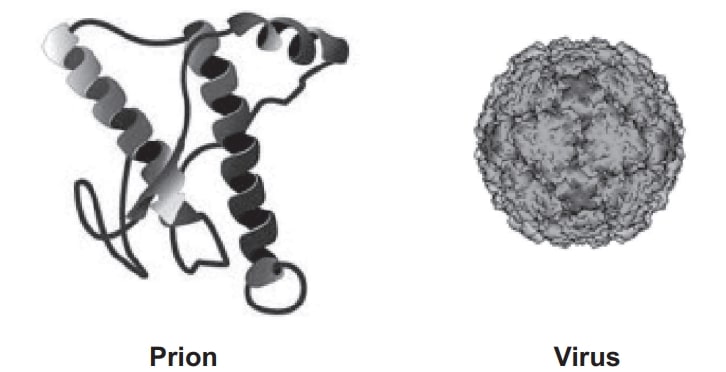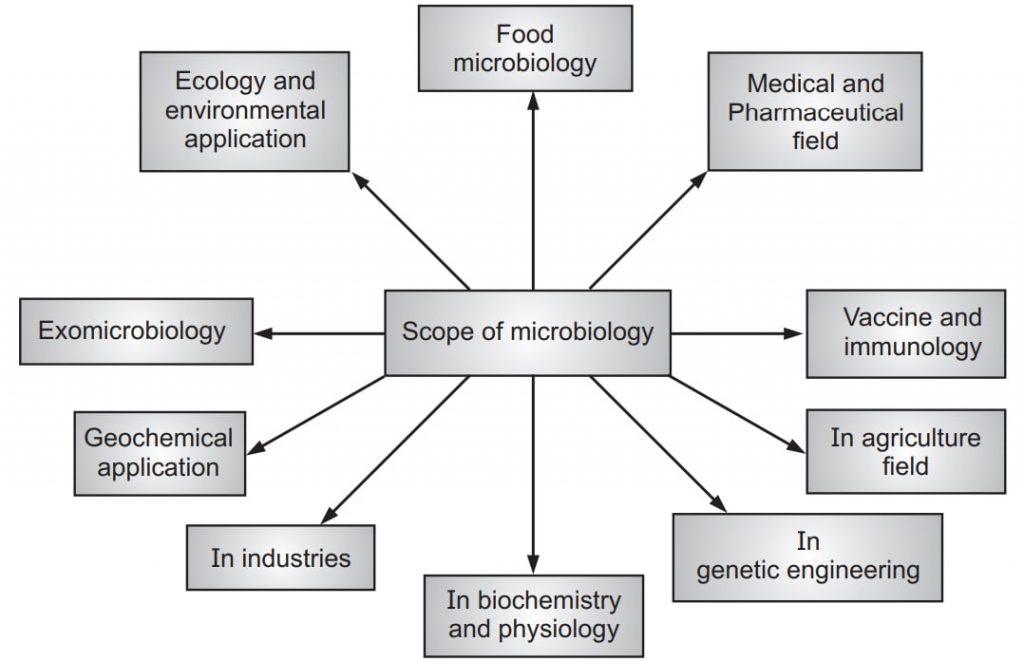INTRODUCTION
Microbiology is the branch of science that deals with microorganisms. Microorganisms are small living things that include unicellular, multicellular, or acellular. Unicellular are single cells organisms like cocci, bacilli, virio, and spirilla (Fig.1). Multicellular are filaments and sheaths form cell colonies like blue-green algae (cyanobacteria), fungi, protozoans, and bacteria (Fig.2) whereas acellular are organisms without cells, like viruses, prions (Fig.3). These microorganisms are not visible by naked eyes, only observed under a microscope. Like other organisms, microorganisms survive, grow, and are also require a source of energy and nourishment to survive and to grow. Many microorganisms are beneficial to humans and some are pathogenic.



BRANCHES OF MICROBIOLOGY
General microbiology is classified into main three branches which are tabulated below.

By Taxonomy
- Bacteriology: It is the study of bacteria.
- Immunology: It is the study of the immune system. It looks at the relationships between pathogens such as bacteria and viruses and their hosts.
- Mycology: It is the study of fungi, such as yeasts and molds.
- Nematology: It is the study of nematodes (roundworms).
- Parasitology: It is the study of parasites. Not all parasites are microorganisms, but many are. Protozoa and bacteria can be parasitic; the study of bacterial parasites is usually categorized as part of bacteriology.
- Phycology: It is the study of algae.
- Protozoology: It is the study of protozoa, single-celled organisms like amoebae.
- Virology: It is the study of viruses.
By Type of Research
- Astromicrobiology: It is the study of the origin of life on Earth, and the search for extraterrestrial life.
- Evolutionary microbiology: It is the evolution of microorganisms.
- Microbial cytology: It is the study of microscopic and submicroscopic details of microorganisms.
- Microbial physiology: It is the study of biochemical functioning of the microbial cells for the study of microbial growth, microbial metabolism, and microbial cell structure.
- Microbial ecology: It is the relationship between microorganisms and their environment.
- Microbial genetics: It is the study of how genes are organized and regulated in microbes to their cellular functions which are closely related to the field of molecular biology.
- Cellular microbiology: It is a discipline bridging microbiology and cell biology.
- Evolutionary microbiology: It is the study of the evolution of microbes. This field can be subdivided into:
(a) Microbial taxonomy: It is the study of naming and classification of microorganisms.
(b) Microbial systematics: It is the study of the diversity and genetic relationship of microorganisms.
- Generation microbiology: It is the study of those microorganisms that have the same characters as their parents.
- Molecular microbiology: It is the study of the molecular principles of the physiological processes in microorganisms.
- Nano microbiology: It is the study of those microorganisms on the Nano level.
- Biological agent: It is the study of those microorganisms which are being used in weapon industries.
Applied Microbiology
- Medical microbiology: It is the study of the pathogenic microbes that are responsible for human illness. It includes the study of microbial pathogenesis and epidemiology and is related to the study of disease pathology and immunology.
- Pharmaceutical microbiology: It is the study of microorganisms that are related to the production of antibiotics, enzymes, vitamins, vaccines, and other pharmaceutical products and that cause pharmaceutical contamination and spoil.
- Industrial microbiology: It is the exploitation of microbes for use in industrial processes like industrial fermentation and wastewater treatment which is linked to the biotechnology industry.
- Microbial biotechnology: It is the study of genetic and molecular level manipulation of microorganisms to generate useful products.
- Food Microbiology and Dairy microbiology: It is the study of microorganisms causing food spoilage and food-borne illness.
- Agricultural microbiology: It is the study of agriculturally relevant microorganisms. This field can be further classified into the following: Plant microbiology and Plant pathology, where the interactions between microorganisms and plants and plant pathogens are studied. Secondly soil microbiology: Is the study of those microorganisms that are found in soil.
- Veterinary microbiology: It is the study of the role of microbes in veterinary medicine or animal taxonomy.
- Environmental microbiology: It is the study of the function and diversity of microbes in their natural environments. This involves the characterization of key bacterial habitats such as the rhizosphere and phyllosphere, soil and groundwater ecosystems, open oceans, or extreme environments (extremophiles). This field includes other branches of microbiology such as:
Microbial ecology: It is the study of the relationship of microorganisms with one another with their environment.
Microbially mediated nutrient cycling: It is the study of the movement and exchange of organic and inorganic matter back into the production of matter through microorganisms.
Geomicrobiology: It is the interdisciplinary study of the interactions of microorganisms and earth materials such as soil, sediment, atmosphere, minerals, and rocks.
Microbial diversity: It is the study of the number of species and abundance of each species of microorganisms that are distributed in an ecological community.
Bioremediation: It is a process used to treat contaminated media, including water, soil, and subsurface material, by altering environmental conditions to stimulate the growth of microorganisms and degrade the target pollutants.
Aquatic microbiology: It is the study of those microorganisms that are found in water.
Aero microbiology: It is the study of airborne microorganisms.
SCOPE AND IMPORTANCE OF MICROBIOLOGY
Scope of Microbiology
In the previous headings, various branches of microbiology were discussed and with the view that it is well understood that microbiology has a wide range of scope. It has an impact on medicine, agriculture, food science, ecology, genetics, biochemistry, immunology, and many other fields. Based on the specific groups of the microorganisms, the specialists are known as bacteriologists (Specialist in Bacteria study), virologists (specialist in virus study), mycologists (specialist in fungi study), and so on. Hence, different branches of microbiology have a different role in the advancement of pharmaceutical sciences where microbiologists are actively involved in a research study (immunology, virology, chemotherapy, genetics, etc.), helps to perform diagnostic tests, develops antibiotics and vaccines, protects the environment and plays an important role in food and beverages industries (Fig).

Some of the recent scopes are highlighted below:
1.Ecology and environment:
- Bacteria are primary decomposers as they recycle nutrients back into the environment.
- Winogradsky and M. Beijerinck studied soil microbes and their roles in the sulfur, carbon, nitrogen biochemical cycles.
- Some bacteria are used as bio-pesticides to control Insects pest. For example, Bacillus thuringiensis.
- Microbes are also used to clean up pollutants and toxic wastes through bioremediation. For example, Pseudomonas putida is used to remove petroleum spills.
2. Food microbiology:
- Microbes are used in various food and dairy industries to produce various food products like cheese, pickles, sauerkraut, green olives, yogurt, soy sauce, vinegar, bread, etc. Pasteur (1856) described fermentation technology which helped in the production of Beer, Wine, Alcohol, etc.
3. Medicines: clinical and pharmaceutical microbiology:
Disease Treatment: Microbes are used to produce Antibiotics like Penicillium notatum (Penicillin); discovered by Alexander Fleming (1928). Bacteria also synthesize vitamins that are needed for our body like E. coli. Vitamin-B and K are needed for metabolism and blood clotting respectively. Recently, gene therapy for the treatment of genetic diseases is the advanced scope of microbiology in the medical field.
4. Vaccine and immunology:
- Vaccine activates the immune response. Sir Edward Jenner inoculated people with cowpox to protect against smallpox. Thereafter Pasteur developed the rabies vaccine (1885), Von Behring and Kitasato (1890) produced a toxoid vaccine against diphtheria and tetanus. Furthermore, Metchnikoff (1884) described the role of the phagocytic cell in defense.
5. Genetic engineering:
- Microorganisms are used in Recombinant DNA Technology to manipulate their gene for the production of enzymes, hormones, interferons, etc. Microorganisms are used as a model organisms in molecular biology.
6. Biochemistry and physiology:
- Microorganisms are used as a model for the study of many biochemical and physiological processes.
7. Industrial microbiology:
- Microbes are used for economic and industrial purposes. Like Biotechnology, fermentation technology, food, and beverages, etc. are now established on a large industrial scale for income and there is a scope of the Patient’s right for the procedure used. Proteases, amylase from bacillus are used in textile and detergent industries. Thiobacillus is used in metal processing from mines. Methanococcus is used for the production of methane in the fuel industry.
8. Agriculture microbiology:
Genetic engineering is used for the production of transgenic plants and animals for better production, resistance to environmental fluctuation. Transgenic animals or plants are used as a bioreactor for mass production through molecular farming.
9. Geochemical microbiology:
- Bioleaching: The recovery of minerals from low-grade ores also plays a role in the geochemical cycle.
10. Exomicrobiology:
- It is also exploring for life in outer space.

Importance of Microbiology
Microbiology is a part of our daily life and plays a vital role in the health care system. The importance of microbiology began with the discovery of antibiotics which prevent serious infections. Thereafter vaccination and better sanitation practices reduced the incidence of infectious diseases and most infectious diseases were under control but some are reappearing because pathogens are showing increasing resistance to antibiotics. Hence, many new diseases are emerging and many harmless organisms are discovered as causative agents for new diseases. Furthermore, interest in bioterrorism has progressed in the past few eras. Bioterrorism is terrorism involving the intentional release or dissemination of any pathogenic microorganisms like bacteria, viruses, or toxins that may be in a natural or a human-modified form. The common examples of bioterrorism are anthrax, smallpox, botulinum toxin, bubonic plague, H1N1, AIDS/HIV, zika and ebolaviruses, etc. Recently, microbiologists have also invented the detection of bioterrorism events at the earliest possible moment through RODS (Real-time Outbreak Disease Surveillance). This process is known as biosurveillance. Biosurveillance is the science of real-time disease outbreak detection. Its principles are applied to both natural and man-made epidemics. A tiny electronic chip has been invented to identify a broad range of toxins. It contains living nerve cells that warn of the presence of bacterial toxins. Another fiber-optic tube that is lined with antibodies coupled to light-emitting molecules identifies specific pathogens like anthrax, botulinum, etc. Recent research invented ultraviolet avalanche photodiodes which detect anthrax and other bioterrorism agents in the air in advance. Vaccines are in the research stage to control and prevent many endemic diseases. Recently, the vaccine has been discovered for the treatment of the dengue virus. India is currently working on vaccines to prevent dengue and by the year 2020, it will be in the Indian market. Recently in 2017, a vaccine has discovered against malaria which is 100% effective. The importance of microbiology in various fields is such as:
Pharmaceutical industry: Pharmacists are discovering various antimicrobial drugs to prevent an escalating number of communicable diseases by understanding the human cell mechanism. They work with microbiologists to ensure that drug therapies target opportunistic microbes without harming their human host. Another important role in pharmaceuticals is the use of medically important studies on microbes, such as Bacteriorhodopsin, a protein from the plasma membrane of Halobacterium salinarum.
Medical devices: Microbiology plays a significant role in medical devices like fluorescent fusion. It is mainly used for the fast and precise detection of pathogens in tissue samples. It is a technology for carrying out immunofluorescence studies that may be applied to find specific cells in complex biological systems. Thereafter ultraviolet avalanche photodiodes are devices that detect anthrax and other bioterrorism agents in the air.
Cosmetic Microbiology: Microbial contamination in cosmetic products is a major concern to the industry. Contamination with microorganisms becomes a major cause of both product and economic losses. Not only that but they are also converted into products hazardous for consumers. The water and nutrients present in cosmetics make them susceptible to microbial growth. More often, microorganisms are the cause of offensive odors and changes in viscosity and color.
Microbiological processes are used in waste treatment, particularly dumping, waste incineration, composting, and bio mechanization.
Make sure you also check our other amazing Article on : Eukaryotic v/s Prokaryotic
